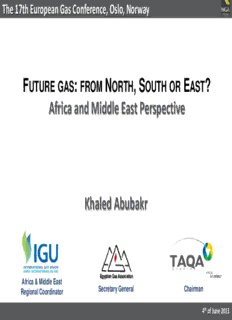
FUTURE GAS: FROM NORTH, SOUTH OR EAST? Africa and Middle East Perspective PDF
Preview FUTURE GAS: FROM NORTH, SOUTH OR EAST? Africa and Middle East Perspective
The 17th European Gas Conference, Oslo, Norway F : N , S E ? UTURE GAS FROM ORTH OUTH OR AST Africa and Middle East Perspective Khaled Abubakr Egyptian Gas Association Africa & Middle East Secretary General Chairman Regional Coordinator 4th of June 2013 I : S O G S F EU NTRODUCTION ECURITY F AS UPPLY OR Recent international events, such as the uprisings in North Africa & Middle East, and the disaster at the Fukushima nuclear plant in Japan, have impacted on the European energy picture. The supply side is undergoing major changes: Europe’s natural gas production has declined in recent years, Political events in key production areas such as North Africa risk to jeopardize the suppliers’ capacity to produce and deliver their natural gas to the markets. Access to alternative supplies such as LNG & Caspian pipeline gas remains limited especially that are not an option at all for some EU countries. Two major types of geopolitical risks need to be taken into account: Source risks; transit risks. 2 F N G S F E UTURE ATURAL AS UPPLY OR UROPE Main gas regions for European supply: North Sea: Norway, United Kingdom, The Netherlands, Denmark Russia Caspian Area & Central Asia: Azerbaijan, Kazakhstan, Turkmenistan, Uzbekistan. South America: Trinidad & Tobago, Venezuela North Africa: Algeria, Libya, Egypt West Africa: Nigeria, Angola East Africa: Mozambique, Tanzania The Arabian Gulf: Qatar, UAE, Oman, Yemen, Saudi-Arabia Middle East: Iran, Iraq 3 N G P R – A 2013 ATURAL AS ROVEN ESERVES FRICA 200 182 180 159 160 140 t 120 e e F 100 c bi 77.2 u 80 C n 54.6 o 60 i l l i r T 40 24.2 12.9 20 4.5 0.23 0 a t a a a e a i p y a l i u c ger Egy Lib geri ngo zan biq Afri Al Ni A an m f T a O z o st M e R Source: www.eia.gov 4 N G P R – M E 2013 ATURAL AS ROVEN ESERVES IDDLE AST 1187 1200 1000 890 t e 800 e F c i b u 600 C n o i l il 400 r 287.8 T 215 200 111.52 63.5 30 16.9 3.25 8.5 0 n r A E n n t q n a Ira Qata KS UA Oma hrai uwai Ira eme Syri a K Y B Source: www.eia.gov 5 R /P R – M E & A ESERVES RODUCTION ATIO IDDLE AST FRICA World proved gas reserves at 2012 were sufficient to meet 63.6 years of production. Africa has an R/P ratio of almost 70 years, while The Middle East still holds the largest re serves and has an R/P ratio of over 150 years. Distribution of proved reserves - 2011 Reserves-to-production (R/P) ratios Years Source: BP Statistical Review of World Energy June 2012 6 A ’ E D D FRICA S NERGY EMAND RIVERS Africa’s population is expected to grow from 1 bn in 2010 to 1.5 bn by 2030, at CAGR of 2%, and almost 3 times World’s CAGR for the same period, being 0.7%. The region median age is 20, compared with 30 in Asia and 40 in Europe. Africa has the fastest-growing middle class. Over the past decade, six of the world’s ten fastest-growing economies were African. In the last ten years, while foreign Aid only grew from USD 20 bn p.a. to USD 28 bn per year, FDI balooned from USD 20 bn per annum to USD 75 bn per annum. Sub-Sahara GDP is forecasted to grow from USD 1.8 tn in 2011 to USD 2.7 tn in 2016 at a CAGR of 7.3% well above the World’s and MENA’s CAGR that are forecasted at 6.1% and 6.3% respectively. 7 A ’ E D D FRICA S NERGY EMAND RIVERS 9,000 8.0% 8,000 7.0% 7,000 6.0% 6,000 5.0% 5,000 4.0% 4,000 3.0% 3,000 2.0% 2,000 1.0% 1,000 0.0% 0 2010 2011 2012 2013 2014 2015 2016 2000 2005 2010 2015 2020 2025 2030 MENA World Sub-Saharan Africa Rest of the World Africa Population (Millions) GDP Growth Rate (%) Source: United Nations Source: International Monetary Fund (IMF) 8 A G O FRICA AS UTLOOK 5,000 255 232 199 4,000 165 Natural gas consumption 132 109 growth in Africa forecasted 3,000 84 Africa to reach a growth rate of 4,469 2,000 4,158 World 3,844 3,570 3.4% p.a. Vs. world’s 3,315 3,052 2,766 1,000 growth rate of 2.1% p.a. 0 Up till 2030, Africa’s 2005 2010 2015 2020 2025 2030 2035 Natural Gas Consumption (BCM) Natural Gas production is projected to record the 5,000 395 372 highest growth rate of 4.3% 342 4,000 311 p.a. Vs. world’s growth rate 272 218 3,000 174 of 1.9% p.a. Africa 4,343 2,000 4,046 3,718 3,436 World 3,189 2,946 Africa is expected to supply 2,621 1,000 more than 10% of the 0 World’s gas by 2030. 2005 2010 2015 2020 2025 2030 2035 Natural Gas Production (BCM) Source: www.eia.gov 9 M E G O IDDLE AST AS UTLOOK 200 24 21.3 Total natural gas 19.1 17 150 14.7 consumption in the Middle 12.5 9.8 East is growing by an 100 Middle East 168.7 average of 2.7% per year 156.8 144.4 133.4 123.1 112.9 Vs. world’s growth rate of 50 101.8 World 2.1% p.a. 0 2005 2010 2015 2020 2025 2030 2035 Industrial consumption of Natural Gas Consumption (TCF) natural gas in the Middle 28.8 East grows by an average 200 26.7 24.6 of 4.5% per year up to 22.3 150 19.7 2015. 16.2 11.3 100 Middle East 157.8 169.2 After 2015, industrial gas 145 133.8 123.6 113 50 99.8 World consumption growth slows to a still robust rate of 0 2005 2010 2015 2020 2025 2030 2035 2.9% per year. Natural Gas Production (TCF) Source: www.eia.gov 10
Description: